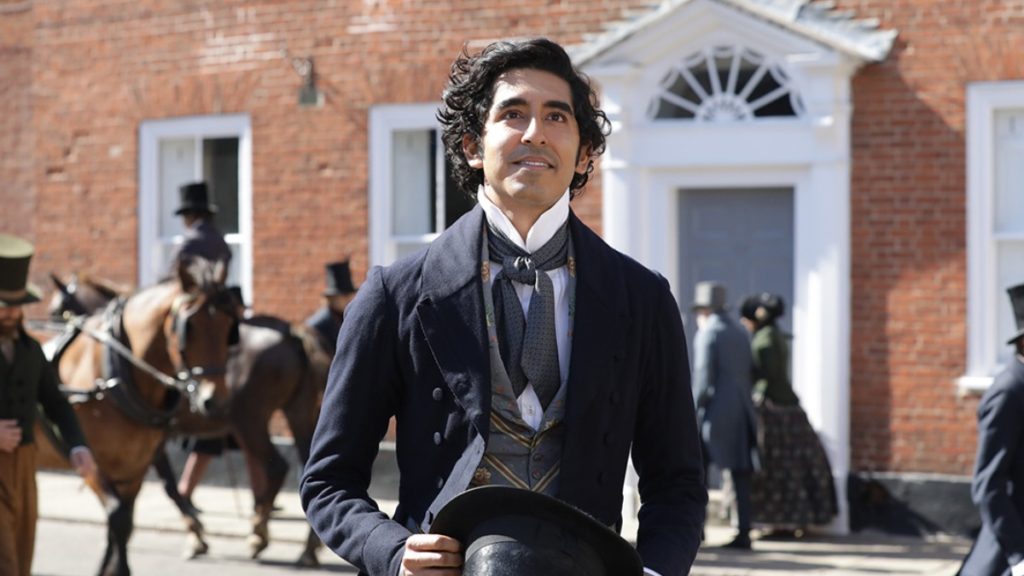I am of the opinion that if we’re going to get yet another adaptation from the literary canon, let’s at least do something interesting with it and shake up the format a little. Thankfully, period pieces such as The Favourite (Yorgos Lanthimos, 2018) and The Great (2020 Hulu TV show about Catherine the Great) are starting to take an irreverent and anachronistic approach to history. And literary adaptations are also heading in that direction, with this year’s Emma (directed by Autumn de Wilde) being one example.
So, hearing that Armando Iannucci – who recently took an anarchic approach to history with The Death of Stalin (2017) – was taking on one of Charles Dickens’ best-known works, was an exciting prospect. Even greater excitement came with the casting of Dev Patel in the titular role, as this confirmed that The Personal History of David Copperfield would look and feel different to most period adaptations.
Colour-blind casting is something that theatre has long been doing, with Shakespeare plays, for example. The BBC is starting to do this more, with a recent example being last year’s Les Miserables, in which David Oyelowo played Javert.
The Favourite: A Battle Between Femininity and Masculinity in Court Politics
It’s important to note that colour-blind casting is not the same as having Black actors play Black characters and for that to be important to the plot, as it is in Sanditon, where Crystal Clarke played Miss Lambe. I am generally in favour of both approaches (if done well, obviously) and having more diverse casts in historical film and television in general.
It is very much a hot topic of discussion at the moment because of Hamilton, but that would be a whole essay in itself. To me, what Lin-Manuel Miranda did was very much purposeful, which is not the same as colour-blind casting, as was Andrea Arnold’s casting of two Black actors to play Heathcliff in her version of Wuthering Heights (2011).
Iannucci has taken a fully colour-blind approach, so that children and parents can be from different cultural backgrounds and it is not commented on within the action. To take this approach in the world of Dickens – where every central character’s journey is predicated on the circumstances of their birth is certainly a choice that forces you to confront class and colonialism even more than usual when watching something set in the Victorian era. Some may want Iannucci to actually wrestle with this and comment on it, instead of taking a more utopian viewpoint, but there is room for different ways of handling more diverse casts in historical films and TV shows.
1994 in Film: The Hudsucker Proxy
The diverse cast is not the only way in which this version of David Copperfield has taken a fresh approach. As Joe Wright did with his wonderful Anna Karenina film in 2012, Iannucci uses Copperfield’s literary origins – and more crucially, the fact that excerpts from the book would have been performed on theatrical stages in Victorian times – to shake up the story.
We are aware throughout that it is Copperfield who is telling and performing this story for us, his audience, so there’s plenty of fourth-wall breaking and meta commentary on the action. Copperfield’s (and by extension, Dickens) love of language is palpable, with him memorialising friends and relations through things they have said to him, carefully recorded on scraps of paper and keep in a special treasure box.
One of the highlights is during a scene set in the beautifully-rendered upturned boat that the Peggottys live in on the beach in Yarmouth. When Murdstone’s God-like hand comes crashing in to abruptly end the scene, much like the giant foot in the Monty Python shows. These touches make for an energetic and frenetic film that will not be to everyone’s taste. As the quick transitions from one section of Copperfield’s life to the next can quite jarring, but it is easy to be swept along with it.
British Cinema: Brief Encounter
It is, of course, down to Patel’s central performance that we are taken along for the ride. He is fantastic as the identity-less everyman, who lets people call him a variety of names (including Daisy) and is at the whims of the fortunes of others. But, of course, at pivotal moments, his rises to the occasion and triumphantly takes a stand against various oppressors.
The large ensemble cast is a wonderful selection of British character actors, along with more unfamiliar faces. And seeing Tilda Swinton and Hugh Laurie together is a personal dream come true. There is also Peter Capaldi, Bronagh Gallagher, Rosalind Eleazar, Benedict Wong, Fisayo Akinade, Nikki Amuka-Bird, Aimee Kelly, Daisy May Cooper, Paul Whitehouse and Anthony Welsh. All bringing lightness, warmth and humour to their roles. And Gwendoline Christie, Darren Boyd, Ben Whishaw and Aneurin Barnard playing the rogue’s gallery of villains and scoundrels – always Dickens’ most memorable characters.
As well as the acting, the costume design by Suzie Harman and Robert Worley, and the score by Christopher Willis deserve shout-outs for being huge reasons why the overall viewing experience is so delightful. I feel like I’ve been waiting forever for the US release of The Personal History of David Copperfield and I wasn’t disappointed. It’s inventive, playful, witty and light and it’s a joy to watch this cast have so much fun around Dev Patel.
This was supposed to be Patel’s year, with A24’s The Green Knight providing a quite different starring role for him, but we don’t know when that will now be released. For now, if you have a safe way of watching David Copperfield, I whole-heartedly recommend it.

